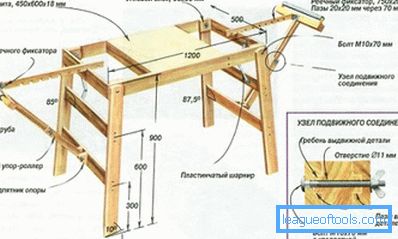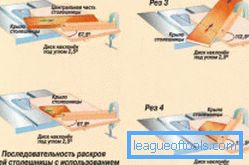How to make a table for a jigsaw with your own hands
Jigsaw is a convenient and useful tool in the household. Electric jigsaw speeds up the work and expands the possibilities of using such a tool. But this quality can be achieved only by installing a stationary device - a table for a jigsaw.

Table layout.
Turning a hand tool into a small machine, you can create original creations from a variety of materials. This table allows you to make the most complex patterns and ornaments. Adaptation, of course, will appeal to lovers of quality manual labor.
Features electric jigsaw
Jigsaw is a type of saw with reciprocating movement of the cutting element (blade), in which the rotational movement of an electric motor is converted into translational movement of the saw in the form of oscillatory movements with a frequency of up to 50 cycles per second. Such a jigsaw ensures the manufacture of cuts inside a flat sheet in any direction, incl. with a twist in an arc with a diameter of at least 3 cm. Many materials can be cut with it: chipboard, wood (up to 70 mm thick), metal sheet (steel - up to 3 mm, copper, aluminum - up to 20 mm), tile, plastic , natural and artificial stone.
Sawing material produced by moving the file up. In addition, the nail file is provided lateral oscillation due to the presence of the pendulum mechanism. This improves the quality of straight lines when sawing. The tool provides for the adjustment of the speed of movement of the nail file, which is important when cutting different materials.

The scheme of work on the circular table.
So, when sawing in a tree, you can set the maximum speed; when working with plastic or aluminum should use an average range of speeds; for steel and tile, the speed must be reduced to a minimum. A special mechanism allows for cutting when inserting the file at an angle.
The file is fastened in the jigsaw with its shank, in which a slot is made (the best option is a cross shape). The shank is fixed in the block with two screws. The design of the pressure pads (cartridges) in different electric jigsaws may be different. The files themselves have different tooth shapes for different materials.
Back to table of contentsFeatures of a desktop fret saw
The use of a manual jigsaw means that the workpiece is permanently fixed, and the sawing is done by manually moving the jigsaw. The quality of the cut in this case completely depends on the “hardness of the hand” and the skills of the master: line accuracy, angle of sawing, etc. The table jigsaw changes the picture of the process: the electric jigsaw is fixed permanently in a vertical position from the bottom of the table, and the workpiece moves along the table surface only guided by hands.

Diagram of the electric jigsaw.
In this case, firstly, the process of sawing is facilitated physically; secondly, the quality of the cut increases due to the strict verticality of the file and the accuracy of movement of the workpiece when using guides. In addition, the location of the file in the upward direction reduces the risk of chipping the surface at the edges of the cut. The file has the stability of movement through the use of mechanisms to ensure its tension and precise orientation. Jigsaw securely mounted on a fairly massive and durable frame, which eliminates unwanted vibrations and movement of the tool.
In general, the table jigsaw is a stationary machine. Its design includes a table with an electric jigsaw attached to it, as well as a system of direction and tension of the file and a system of fastening and direction of the workpiece. The simplicity of the design allows you to make a table with your own hands. The size of the table is selected based on the size of the workpiece and parts. For the installation of sheets of considerable size (for example, particleboard) additional extension systems may be provided.
Back to table of contentsSimplest design
The simplest table with your own hands can be done very quickly. A plywood sheet with a minimum thickness of 10 mm and a size depending on the size of the workpiece is used as the working surface. For small workpieces, it is enough to take a sheet of 50x50 cm. In the central part, departing about 20-25 cm from the edge of the sheet, a hole with a diameter of 20-30 mm is drilled for the jigsaw. From the bottom of the sheet, using the hole as a center, marks the fastening of the jigsaw sole. If there are no holes on the bottom of the jigsaw, then they must be drilled on a drilling machine in the amount of 4 pieces and cut the thread M8-M10. On marks four holes are drilled in the sheet of plywood.

The assembly scheme of the front of the table.
At the corners of the sheet legs are fastened from steel strips with a thickness of 3-4 mm and a width of 30-40 mm. The height of the legs is determined by the size of the jigsaw body (to the sole) with the addition of 2-3 cm. The bottom slats of the legs need to be bent at a right angle outwards and drill 1-2 holes of 6-8 mm in diameter for fastening. The electric jigsaw is attached to the bottom of the plywood sheet so that the file goes out through the hole. The simplest table is made by hand, which can be fixed on any surface (workbench, table, etc.) and work.
Even simpler design does not provide legs, and is attached to the edge of the workbench on the clamp (two on each side for durability). Jigsaw should be outside the workbench. Such a table with their own hands can easily cope with wooden blanks up to 3 cm thick.
Back to table of contentsMinor design complication
You can make a little more complicated table with your own hands. To do this, a frame is made of three chipboard panels with a thickness of 12–15 mm (two side panels of 50x80 cm in size and a back panel of 70x80 cm in size). The structure is assembled with the help of a wooden block or furniture corners. At the bottom it is advisable to make a reinforcing jumper from a wooden bar. Ahead of the bed does not close to provide access to the start button.
The top panel of a sheet of plywood with a thickness of 10-12 mm and a size of 70x100 cm is equipped with a jigsaw, similar to the simplest design. To eliminate the fluctuations of the file during cutting provides a simple stabilization system. The file is passed between two bearings with a diameter of 10-12 mm. Bearings are mounted on a bracket of steel strip, which, in turn, are fixed on the table top. On the table top, you can install guides and limiting slats from a wooden bar or aluminum profile. Fastening them to the edges of the tabletop is better to implement clamps, which will give the opportunity to move them along the table. To accurately move at the ends of the tabletop, you can fix the scale from the tape measure.
Back to table of contentsTable on the basis of bars
A more complex design involves the manufacture of a table of wooden bars. In this case, the table is assembled from a bar (legs from a bar of 80x80 mm, jumpers from a bar of 40x80 mm) with a joint along the thorn-groove system.
For the hardening of the structure it is necessary to use wood glue, dowels and screws. The distance between the legs is 60-70 cm. The legs are reinforced with collet. At the junction of the bars and collet holes are drilled and fixed dowels. The height of the table is set by the manufacturer based on the ease of maintenance of the machine.
The tabletop is made of laminated plywood with a thickness of 18-20 mm and the size of 90x90 cm. For ease of changing the file, the tabletop is made in a lifting version. To do this, on one of the collet of the table, it is attached with hinges. The file is more convenient to remove if it is cut from the hole to the edge of the tabletop. Such a cut is recommended to do.
Jigsaw attachment system should be complicated to ensure its removal. The jigsaw sole is pressed against the table top with two wooden planks, on which a profile is made by sampling a quarter of a bar. In this profile, as on the runners, includes the sole of the jigsaw. For its fastening holes are drilled in the bar and clamping screws with a thumb are installed.
Back to table of contentsTable with a thin file
When cutting complex shapes, especially on plywood, the use of thin files is necessary.
The jigsaw table in this case should have a file tension system. This will help self-made device.
Tension is provided by a spring-loaded rocker. Mounted on the countertop bracket with a transverse stud.
One end of the spring is fixed to the stud, and the other end is mounted in the adjusting screw. A slit is made on the lever of the yoke, into which the end of the file is inserted. Using clamping plates and a screw with a nut, the file is fixed on the beam.
For convenience, the table can be equipped with a foot switch. The simplest device is based on the fact that a hook is attached to the jigsaw button, which is connected to a homemade pedal. This pedal is made of two spring-loaded metal strips. The stroke of one strip relative to another must be at least 10 mm.
A more complicated foot switch design is based on the use of a switch from a sewing machine. In this case, the jigsaw button is bypassed, and the power is supplied via a foot switch.
Back to table of contentsBasic rules for working on the jigsaw table
When working on a jigsaw table, you should follow certain rules. When cutting, it is impossible to feed the workpiece to the file with great effort in order to avoid its breakage. The file wears out pretty quickly and it must be periodically replaced with a new one. When processing thin metal sheets under them it is recommended to enclose plywood. Jigsaw should be securely fastened. Long cuts should be carried out using guide rails.
The parameters of the file should correspond to the material being processed. If laminated material is being sawed, then it is better to pre-stick a strip of scotch tape in place of the cut in order to prevent chipping. When making circular cuts, the jigsaw pendulum should be set to a minimum.
Back to table of contentsNecessary tool
In order to make a table with your own hands, you need the following tool:
- Bulgarian;
- electric drill;
- hacksaw;
- hacksaw;
- file;
- chisel;
- chisel;
- hammer;
- pliers;
- vice;
- screwdriver;
- a set of taps;
- set of dies;
- sanding pelt;
- screwdriver;
- ticks;
- calipers;
- roulette;
- line meter;
- level;
- paint brush
Jigsaw is a very necessary tool for home craftsman. With it, you can make quite complex shapes from different materials. A table with your own hands for a jigsaw will help facilitate the work and improve its quality.